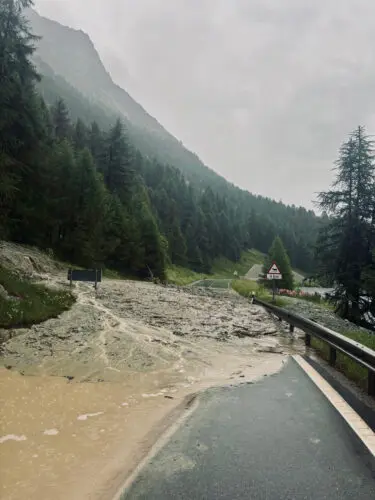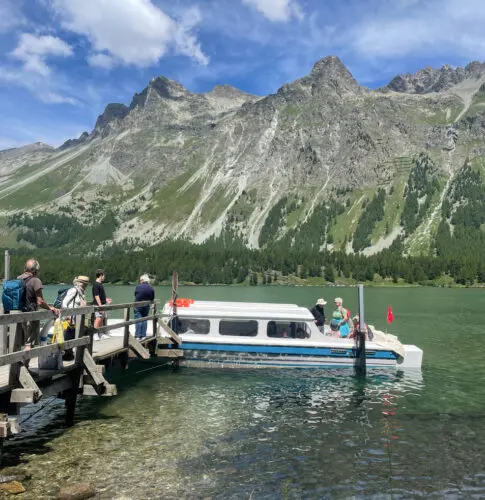Verity Ockenden writes about a training camp incident which provided some valuable lessons and a stark reminder that even elite athletes are not immune to the issues caused by climate change
One fine Swiss morning midway through an altitude camp recently, three Australians and a Brit (me), packed their rucksacks full of electrolytes, spikes and protein shakes and set off for the small Italian town of Chiavenna. It’s a fairly well-trodden weekly pilgrimage for track runners who are training in St Moritz, but what happened next was a lot more than any of us bargained – or packed – for.
The aim of the excursion was to take advantage of the more oxygenated air at the town’s local track, where we would be able to hit some faster splits than would be possible at altitude. It was to be a gruelling morning of work, but we were bolstered by the idea of refuelling with pizza and gelato afterwards.
We anticipated a hot day and as we descended from the cool heights of St Moritz through the winding hairpins of the Maloja Pass, the temperature increased with each curve negotiated. By the time we arrived at the track after an hour of driving, there was little cloud cover and we were hosing ourselves off at the tap after just the warm-up. Bendere did tempo work while Maudie, Natalie and I took on a mile breakdown.

Nestled among emerald mountains and with an azure tartan that perfectly reflected the summer sky, it was a beguiling location that seemed to lure me into a false sense of security as to what I was about to endure there. Surely pain could not be painted on to such a beautiful backdrop, but we managed it, leaving pools of sweat in our wake and jumping straight into the neighbouring river for relief once the masterpiece was complete.
We had each brought a towel and a change of clothes for lunch, and we took our time hunting down and devouring our long-awaited pizza in Chiavenna’s picturesque high street. By the time we left at around three pm (all of us accustomed to taking afternoon naps after workouts), we were becoming weary-eyed and took little heed of the darkening horizon as we sped back up the mountain.
As we rounded the final curve of the Maloja Pass that brought us back onto the Engadin plateau, we were less than 20 minutes away from our apartment when we crossed a small mound of mud that the gradually intensifying rain had driven on to the road in front of us. We thought little of it and carried on, flanked by the rocky slopes of the mountain on our left and the shores of the Silsersee lake on our right, unaware that 300 metres ahead of us lay a much larger mound of mud that had blocked the road entirely.

We waited patiently for the traffic to clear but it never did, and by the time we had been informed of the landslide ahead and instructed to turn around, the original mound of mud that we had so casually just driven over had swollen to mammoth proportions, cascading across the road and into the lake, blocking our only route out. It was at this point that we started to panic slightly, and to make matters worse it was now hailing, with flashes of lightning peppering the skies. One leather-clad biker began fear-mongering that the whole section of mountain looming above us could become unstable. Horrified, we hastily put on our trainers, pocketed our passports and valuables and went to inspect the possibility of abandoning our hire car and proceeding cross-country (to who knows where) on foot.
It soon became apparent how ridiculous an idea that would be, and by the time we’d walked the length of the section of road we were trapped in, wearing only our summery shorts and t-shirts, we were all soaked to the skin and freezing. Three hours passed and we ran out of food, water and three out of four phone batteries, with the car’s engine battery also beginning to run low.
We played “Hangman” in the condensation of the windshield to kill time while a single digger attempted to carve a path through to us, and as boredom set in we even contemplated using the last 20 per cent of Maudie’s phone battery to live stream Faith Kipyegon’s attempt at breaking the four-minute mile.
Having realised that, if and when we got out, we would still be unable to return to St Moritz before nightfall since the only landslide being cleared was in the direction of Chiavenna and the only other route into St Moritz would entail a three-and-a-half-hour drive back down to Chiavenna and up the Julier Pass, we settled on using the last iPhone dregs for something more sensible: a reservation at the nearest hotel in the next village.
Like starving artists, we booked the cheapest we could find, which in true St Moritz style was still extortionate and turned out to be the sort of place at which you were supposed to dress for dinner. As we dripped our way across the gilded lobby, the receptionist could barely stand the sight of us, let alone offer any kind of help or advice. At dinner at a much friendlier locale across the road we ate pasta by candlelight in a wooden-clad snug, where the restaurateur found plug sockets and chargers for all of our devices and our fellow diners listened in jovially as we recounted our tale.
The next morning, with the road into St Moritz still blocked for the foreseeable future, Natalie caught wind of a 15-person ferry that crossed the lake from Maloja and arrived the other side of the landslide in Sils where we could hike through the woods to a bus stop. Not before getting a 10km run in the books, we set off for the dock in yesterday’s clothes and squeezed ourselves on to the tiny craft amongst the other similarly stranded tourists.

As we chugged across the now tranquil lake, leaving the car to be picked up later whenever the road re-opened, the sun sparkled in the boat’s wake and we couldn’t help but grin at the absurdity of it all. My friend Fabienne, a Swiss marathoner also training in the area, kindly came to pick us up and drove us the remaining 15 minutes back to St Moritz where we spent the rest of the day catching up on recovery.
While nobody could quite believe our bad luck when we told them what our regular workout day had turned into and we were admittedly a little physically drained from our impromptu adventure, the experience served as a valuable lesson that I won’t forget in a hurry.
We think we can stay ahead of the global warming game by training to accustom ourselves to rising summer temperatures, but the resulting excess meltwater and flash flooding in mountainous regions mean it becomes quickly apparent how powerless we are against the level of natural destruction we have caused. As athletes we pride ourselves on our invincibility, but forget how fragile human life really is.
We get wrapped up in chasing results like our lives depend on it, but put our lives on the line and all of that fades away into a simpler gratitude for sheer existence and the presence of friends and family.
I think we all left that camp feeling a little more conscious of real perspective in life, having had all of our small “problems” – such as how successful the day’s training had been – dwarfed by the laws of nature, under the assumption that however well or badly a day’s work could go, we would always make it home.
It all sounds a bit dramatic, but on our return there was also a quiet sense of satisfaction in having had our resilience put to the test and been resourceful, in having sat with discomfort and uncertainty, and found ways to overcome and even enjoy those moments shared together.
Those are all qualities that we strive for as runners and put to the test when we race, but perhaps the real reason that we search for them in race scenarios is to know that they’ll be there in real life when we need them.
